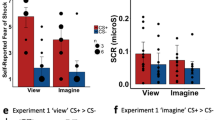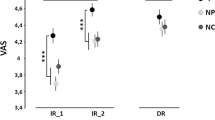Abstract
The present study tested the hypothesis that autonomic responding to imagery instructions can be enhanced by increasing the number of stimulus modalities associated with the feared stimulus. This prediction was supported by the skin-conductance frequency data. The theory under consideration also resulted in a prediction that imagery ratings of clarity would initially be lower as the number of modalities (stimulus intensity of the scenes) increased. It was further predicted that with scene repetition and subsequent fear extinction, imagery clarity would then increase. The scenes were presented in the form of stimulus propositions. The data supported both of these predictions. An additional hypothesis that the autonomic differences between subjects who rated themselves prior to the experiment as either low or high in fear to the target stimulus would diminish as a direct function of an increase in the number of stimulus modalities presented was only partially supported. The paper presents the underlying rationale for these predictions as well as noting the clinical relevance of the findings.
Similar content being viewed by others
References
Anderson, M. P., & Borkovec, T. D. (1980). Imagery processing and fear reduction during repeated exposure to two types of phobic imagery.Behaviour Research and Therapy, 18 537.
Bauer, R., & Craighead, W. E. (1979). Psychophysiological responses to the imagination of fearful and neutral situations: The effects of imagery instructions.Behavior Therapy, 10 389–403.
Carroll, D., Marzillier, J. S., & Merian, S. (1982). Psychophysiological changes accompanying different types of arousing and relaxing imagery.Psychophysiology, 19 75–82.
Carroll, D., Marzillier, J. S., & Watson, F. (1980). Heart rate and self-report changes accompanying different types of relaxing imagery.Behaviour Research and Therapy, 18 273–280.
Dollard, J., & Miller, N. E. (1950).Personality and psychotherapy. New York: McGraw-Hill.
Edelberg, R. (1967). Electrical properties of the skin. In C. Brown (Ed.),Methods in psychophysiology. Baltimore: Williams and Wilkins.
Elliott, R. (1974). The motivational significance of heart rate. In P. A. Obrist, A. H. Black, J. Brener, & L. V. DiCara (Eds.),Cardiovascular psychophysiology: Current issues in response mechanisms, biofeedback and methodology. Chicago: Aldine.
Foa, E. B., & Kozak, M. J. (1986). Emotional processing of fear: Exposure to corrective information.Psychological Bulletin, 99 20–35.
Geer, J. H. (1965). The development of a scale to measure fear.Behaviour Research and Therapy, 3 45–53.
Kaloupek, D. G., & Levis, D. J. (1980). The relationship between stimulus specificity and selfreport indices in assessing fear of heterosexual social interaction: A test of the unitary response hypothesis.Behavioral Assessment, 2 267–281.
Kaloupek, D. G., Peterson, P. A., Boyd, T. L., & Levis, D. J. (1981). The effects of exposure to a spatial ordered fear stimulus: A study of generalization of extinction effects.Behavior Therapy, 12 130–137.
Lacey, J. I. (1959). Psychophysiological approaches to the evaluation of psychotherapeutic process and outcome. In E. A. Rubenstein & M. B. Parloff (Eds.),Research in psychotherapy (Vol. 1). Washington, DC: American Psychological Association.
Lacey, J. I., & Lacey, B. C. (1970). Some autonomic-central nervous system interrelationships. In P. Black (Ed.),Physiological correlates of emotion. New York: Academic Press.
Lang, P. J. (1977). Imagery in therapy: An information processing analysis of fear.Behavior Therapy, 8 862–886.
Lang, P. J., Kozak, M. J., Miller, G. A., Levin, D. N., & McLean, A., Jr. (1980). Emotional imagery: Conceptual structure and pattern of somato-visceral response.Psychophysiology, 17 179–192.
Lang, P. J., Levin, D. N., Miller, G. A., & Kozak, M. J. (1983). Fear behavior, fear imagery, and the psychophysiology of emotion: The problem of affective response integration.Journal of Abnormal Psychology, 92 276–306.
Lang, P. J., Melamed, B. G., & Hart, J. (1970). A psychophysiological analysis of fear modification using an automated desensitization procedure.Journal of Abnormal Psychology, 76 229–234.
Levis, D. J. (1969). The phobic test apparatus: An objective measure of human avoidance behavior to small objects.Behaviour Research and Therapy, 7 309–315.
Levis, D. J. (1980). Implementing the technique of implosive therapy. In A. Goldstein & E. B. Foa (Eds.),Handbook of behavioral interventions. A clinical guide (pp. 92–151). New York: Wiley.
Levis, D. J. (1985). Implosive theory: A comprehensive extention of conditioning theory of fear/anxiety to psychopathology. In S. Reiss & R. R. Bootzin (Eds.),Theoretical issues in behavior therapy. New York: Academic Press.
Lick, J. R., Sushinsky, L. W., & Malow, R. (1977). Specificity of fear survey schedule items and the prediction of avoidance behavior.Behavior Modification, 1 195–204.
Lykken, D. T., & Venables, P. (1971). Direct measurement of skin conductance: A proposal for standardization.Psychophysiology, 8 565–672.
May, J. R. (1977). Psychophysiology of self-regulated phobic thoughts.Behavior Therapy, 8 150–159.
McReynolds, W. T., & Stegman, R. (1976). Sayer versus sign.Behavior Therapy, 7 704–705.
Mowrer, O. H. (1960).Learning theory and the symbolic processes. New York: Wiley.
Obrist, P. A. (1981). Cardiovascular psychophysiology—A perspective. New York: Plenum.
Obrist, P. A. (1983). Cardiac-behavioral interactions: A critical appraisal. In J. T. Cacioppo & R. E. Petty (Eds.),Perspectives in cardiovascular psychophysiology. New York: Guilford Press.
Paivio, A. (1971).Imagery and verbal processes. New York: Holt, Rinehart & Winston.
Peterson, D. A., & Levis, D. J. (1985). The assessment of bodily injury fears via the behavioral avoidance slide-test.Behavioral Assessment, 7 173–184.
Rescorla, R. A., & Solomon, R. L. (1967). Two-process learning theory: Relationships between Pavlovian conditioning and instrumental learning.Psychological Review, 74 151–182.
Robinson, A., & Reading, C. (1985). Imagery in phobic subjects: A psychophysiological study.Behaviour Research and Therapy, 23 247–254.
Sheehan, P. W. (1972).The function and nature of imagery. New York: Academic Press.
Stampfl, T. G. (1970). Implosive therapy: An emphasis on covert stimulation. In D. J. Levis (Ed.),Learning approaches to therapeutic behavior change. Chicago: Aldine.
Stampfl, T. G., & Levis, D. J. (1987). The essentials of implosive therapy: A learning-theorybased psychodynamic behavioral therapy.Journal of Abnormal Psychology, 72 496–503.
Tecce, J. J., & Cole, J. D. (1972). Psychophysiological responses of schizophrenics to drugs.Psychopharmacologia, 24 159–200.
Van Egeren, L. F. Feather, B. W., & Hern, P. L. (1971). Desensitization of phobia: Some psychophysiological propositions.Psychophysiology, 8 213–228.
Vrana, S. R., Cuthbert, B. N., Lang, P. J. (1986). Fear imagery and text processing.Psychophysiology, 23 247–253.
Weerts, T. C., & Lang, P. J. (1978). The psychophysiology of fear imagery: Difference between focal phobia and social-performance anxiety.Journal of Constulting and Clinical Psychology, 46 1157–1159.
Wolpe, J. (1958).Psychotherapy by Reciprocal Inhibition. Stanford: Stanford University Press.
Author information
Authors and Affiliations
Rights and permissions
About this article
Cite this article
Holzman, A.D., Levis, D.J. The effects of increasing the number of stimulus modalities included in a fear-eliciting imagery scene on reported imagery clarity, scene repetition, and sympathetic (fear) arousal. Cogn Ther Res 13, 389–405 (1989). https://doi.org/10.1007/BF01173481
Issue Date:
DOI: https://doi.org/10.1007/BF01173481




